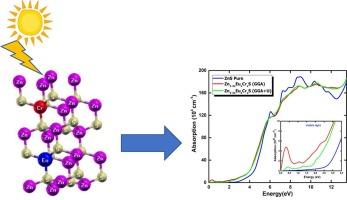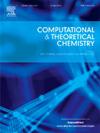Study of optoelectronic, thermoelectric and induced half-metallicity in Wurtzite ZnS via codoped (Eu, Cr): A DFT method
IF 3
3区 化学
Q3 CHEMISTRY, PHYSICAL
引用次数: 0
Abstract
Based on the Density Functional Theory (DFT), we have successfully examined the wurtzite sulfide (ZnS) codoped with the couple (Eu, Cr). This study calculates the electronic, magnetic, optical, and thermoelectric (TE) properties using the GGA and GGA + U methods. Our results find that the ferromagnetic alignment of spin is more stable than its antiferromagnetic coupling. Most notably, a half-metallic behaviour is observed in the codoped material, exhibiting 100 % spin polarization at the Fermi level. However, the origins of ferromagnetism in the complex Zn1-2xEuxCrxS, x = 0.0625, are due to hybridization between S-3p, Cr-3d, and Eu-4f states in the case of the GGA approximation and p-f hybridization in the case of GGA + U. The insertion of double impurities leads to a compound with a large half-metallic gap. The optical simulation of ferromagnetic alloy reveals a high absorption coefficient at the ultraviolet spectrum level and a low reflectivity in the visible range. Furthermore, the calculation of the figure of merit ZT ∼ 1 proves that we have an efficient material for converting thermal energy into electricity. All these qualities combine to make a half-metallic ferromagnetic material efficient for spintronic, optoelectronic, and thermoelectric applications.

共掺杂(Eu, Cr)研究纤锌矿ZnS的光电、热电和诱导半金属丰度:DFT方法
基于密度泛函理论(DFT),我们成功地研究了硫化纤锌矿(ZnS)与铕、铬偶联共掺杂。本研究使用GGA和GGA + U方法计算了电子、磁性、光学和热电(TE)性质。我们的结果发现自旋的铁磁排列比它的反铁磁耦合更稳定。最值得注意的是,在共掺杂材料中观察到半金属行为,在费米能级上表现出100%的自旋极化。然而,配合物zl1 - 2xeuxcrxs (x = 0.0625)的铁磁性来源于GGA近似下的S-3p、Cr-3d和Eu-4f态之间的杂化,以及GGA + u下的p-f杂化。双杂质的插入导致化合物具有较大的半金属间隙。对铁磁合金的光学模拟表明,铁磁合金在紫外光谱水平上具有较高的吸收系数,在可见光范围内具有较低的反射率。此外,通过计算ZT ~ 1的性能值,证明我们拥有了将热能转化为电能的有效材料。所有这些品质结合在一起,使Zn1−2xEuxCrxS成为一种半金属铁磁性材料,适用于自旋电子、光电和热电应用。
本文章由计算机程序翻译,如有差异,请以英文原文为准。
求助全文
约1分钟内获得全文
求助全文
来源期刊

Computational and Theoretical Chemistry
CHEMISTRY, PHYSICAL-
CiteScore
4.20
自引率
10.70%
发文量
331
审稿时长
31 days
期刊介绍:
Computational and Theoretical Chemistry publishes high quality, original reports of significance in computational and theoretical chemistry including those that deal with problems of structure, properties, energetics, weak interactions, reaction mechanisms, catalysis, and reaction rates involving atoms, molecules, clusters, surfaces, and bulk matter.
 求助内容:
求助内容: 应助结果提醒方式:
应助结果提醒方式:


